Places Visited: Wyoming: The scenic Teton National Park
July
30 through August 5, 2006: Colter Bay Village Campground in Teton National Park
near Moran, Wyoming: N43° 54.659' W110° 38.526' $15.00 NO hookups with
paved interior roads and gravel spots. Nice, clean park and you really do not
need hookups in the summer.
August 5, through August 12, Gros Ventre Campground
in Teton National Park near Jackson, Wyoming: N43° 36.979' W110° 40.000'
$15.00 NO hookups with paved interior roads and gravel spots. Nice, clean park
and you really do not need hookups in the summer.
We moved the motorhome
from Jackson Hole to Colter Bay Village in the northern part of Teton National
Park. That entire drive was through Teton National Park Valey, with the mighty
Tetons providing a backdrop on our western flank. A more scenic drive is hard
to find. Eight days later we retraced our path and moved the motorhome south to
Gros Ventre Campground just north of Jackson where we spent another week.
Geologist
look at the Tetons and marvel at the structure. With trained eyes they see thing
most of us would not notice. One of those things is a prominent "fault scarp".
A fault scarp provides visual evidence of displacement of adjoining blocks of
the earth's crust along a fault. The "scarp" in this picture shows nearly
60-feet of movement, mostly in the down-dropping of the valley. This movement
generated earthquakes of the highest magnitude.
Geologists estimate that
displacement will continue as it has for the last nine million years. Through
periodic earthquake producing jolts, the mountains will hinge upward and the valley
will tilt downward.
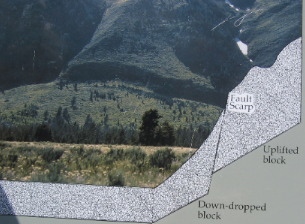
The
Teton Range, one of many minor ranges associated with the Rocky Mountains, is
in its early stages of development. Though associated with the Rockies, the Tetons
are much younger and have formed in a different way.
During the past 5 to
9 million years, cataclysmic earthquakes rumbled along the Teton Fault, a break
in the Earth's crust. West of the fault mountains rose, while east of the fault
a valley, now known as Jackson Hole, sank. The Teton Range, with its absence of
foothills and exceptionally steep hillsides on its east side, is a classic example
of a fault block mountain range.
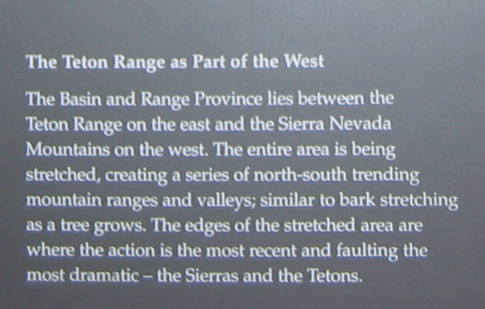

This
cross section shows the uplift of the Teton Range relative to Jackson Hole. Follow
the color throughout the exhibit to better understand the series of events that
created this landscape. Blue represents submersion by tropical seas. Green represents
the time of dinosaurs. Gold represents the present age of mammals. Red represents
the period of Teton Uplift and faulting. Yellow represents recent glacial periods.
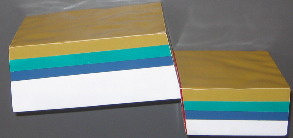
This
model represents the vertical movement along the Teton Fault, 5 to 9 million years
ago. The block to the left represents the Teton Range while the block to the right
represents the valley called Jackson Hole. The colored layers represent rock layers
in their present positions relative to each other across the fault. The movement
along the fault resulted in the valley sinking four times faster than the mountains
rose.
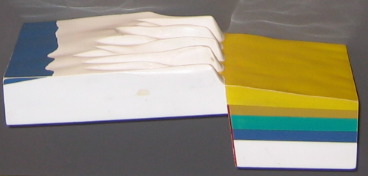
This
model represents the role of glaciers and other weathering processes in sculpting
the mountains since their uplift. The material eroded from mountian valleys, carried
by streams and glaciers and deposited in Jackson Hole has filled the valley with
aboyt 24,000 feet of rocks, sand and clay.
As Fritiof Fryxell, noted geologist
and first Park Ranger explained "The Teton peaks wer not individually upthrust.
They attained their eminence and form through being carved from a common mass...just
as, under the hand of a sculptor, figures are chisled from a block of stone. In
fact, the Teton Range is rightly though of in this way, as a piece of sculpturing,
collossal in scale and superb in composition."
For every foot the mountains
rose, the valley sank about 4-feet. so it wasn't so much a process of mountain
building as it was of valley forming. The sandstone layer that cas Mount Morain,
six thousand feet above the valley, corresponds to a layer of sandstone lying
24,000 feet below Jackson Hole. The total displacement along the teton Fault is
currently 30,000 feet. The mountains do not tower above the valley by this distance
today because the mountains have eroded and the valley has been partially filled
with glacial debris and river gravel.
The geologic processes that resulted
in mountain building and sculpting have aslo determined where plants grow, animals
live, and people play. Where torrents of glacial outwash rivers swept across Jackson
Hole, gravel terraces are covered with sagebrush that survives on dry, rocky soil.
Where rich, water retentive soils have collected in the moraines of those same
glaciers, coniferous forest thrive. Each habitat supports its own collection of
wildlife. The assemblage of those habitats within the context of the Teton Range
affords an unrivaled visual, intellectual, spiritual and physical experience.
Mountain
streams cascade melted snow towards the valley where it is collected by the Snake
River. The cottonwoods and spruces that grow along the Snake River provide ideal
nesting sites for bald eagles. Side channels are sometimes dammed by beavers establishing
small lakes and marshes. Moose wade through yellow pondlily and eat the lush growth
in the wet swampy areas near the river. The swift clean water makes floating the
river or fishing for cutthroat trout a rare treat in a spectacular setting.
I
am just beginning to understand what they call an "outwash plain". Rivers
flowing away from ice age glaciers spread out to form broad outwash plains. Nutrients
and organic matter are carried downstream leaving only gravel and sand. As the
Snake river entrenches itself, these gravel plains are left high and dry as river
terraces.
Being well drained, only plants adapted to arid conditions survive.
Arrowleaf balsamroot is one of the showest spring wildflowers. Elk emerge from
the shade of the forest at dusk to feed. the sagebrush plains offer open views
of the Teton Range and easy observation of herds of wildlife when driving in Teton
National Park.
Comprehending the glaciation that occurred in this region
during the ice age helps put things into perspective. I say comprehending rather
than understanding because of the immense scale of the glaciers that did this
carving. During the "Bull Lake Glaciation" (about 140,000 years ago),
huge volumes of ice moved into Jackson Hole from surrounding mountains, filling
it with glacial ice over 2,500 feet thick in places. Slow down for a minute and
try to comprehend a valley 40-miles long and 10-miles wide filled with glacial
ice over 2,500 feet thick and you can understand why it is so hard to comprehend.
Glaciers only form when the summer melt is less than the winter accumulation.
It must have been so cold during the summer that very little of the winter snow
melted. Folks it takes a lot of snow to accumulate 2,500 feet of ICE.
But
I degress, so back to the Bull Lake Glaciation that formed much of what we see
in Teton National park. Though much of the evidence of this period has been destroyed
by later glacial events, scattered remains indicate it was extensive. The streamlined
shape of some of the bedrock buttes on the valley floor, like East and West Gros
Ventre Buttes, were all sculpted by these glaciers. The melting ice also left
behind a pavement of cobbles.
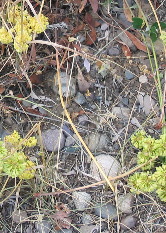
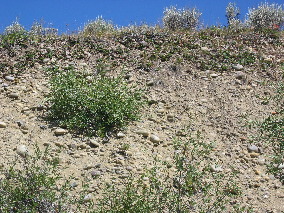
Cobblestones,
river rock whatever you want to call it seems to make up the entire Teton Valley.
No matter where you are there are these rounded cobblestones.

As
you can see by this picture and the one below vegetation has a hard time surviving
in what amounts to a pile of rocks. Some places in the morrain pile have more
soil than others. Erosion, I suspect has played a major role in determining how
much soil remains and how much is washed away.

This
picture was taken just a few feet from the one above yet there is almost no soil
in this pile of cobbles to support plant life.
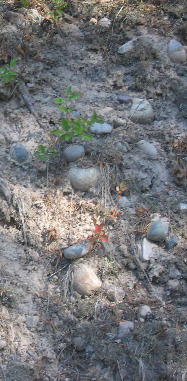
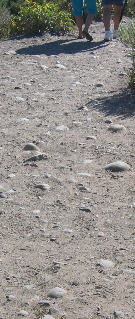
Even
high on Signal Mountain we see these cobble stones in conglomerate near the summit.
The glacier that created Jenny Lake and Signal Mountain was pushing this incredibly
large wall of morrain. I suspect Signal Mountain is 800' to 1,000' above the floor
of the valley. As far as I could tell Signal Mountain is nothing more than morrain.
The picture to the left is from a roadcut near the summit while the picture to
the left is a trail along the summit leading to an overlook. Both are composed
of cobblestones from the leading edge of that glacier, making Signal Mountain
one gigantic pile of morrain.
As the
Teton Range was uplifted, erosion began to modify its appearance. Streams cut
canyons, expanding ice and growing tree roots widen cracks, weathering takes its
toll on unstable minerals and, pulled by gravity, rocks roll down steep slopes.
glacial ice was a major agent of erosion over the last 2-million years. Glaciers
pushed their way down once-narrow canyons grinding rock away to form broad U-shaped
valleys. the hardest rocks remained as jagged peaks, chiseled on all sides. Erosion
during the Ice Ages has had the greatest effect on the landscape of the Teton
Range and Jackson Hole. When erosion finally outpaces uplift, the Teton peaks
will become low hills and flatlands, but that will not be in our lifetimes.
To
understand how a glacier operates is to understand how the majestic Teton's were
formed from a solid block. A glacier forms whenever more snow collects than is
melted during the summer. After successive periods of snow accumulation, the snow
is compressed into "blue ice" and begins to flow downhill under its
own weight. Rocks are plucked from beneath the glacier and are carried along acting
like sandpaper, gouging the valley bottom and sides into a characteristic U-shape.
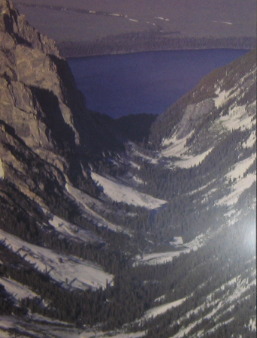
As
glaciers leave the confines of stone-walled canyons and spread out, they dig deeply
into the gravel filled valley. When the glacier melts, the rock debris is left
in piles called terminal moraines creating deep lakes.
You can see all those
things in this picture of Cascade Canyon, the U-shaped canyon walls, the deep
lake, and the huge pile of rocks (terminal moraine) on the far side of the lake.
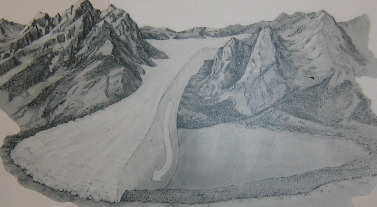
The
glacier that shaped Cascade Canyon (pictured above) looked somewhat like this.
When it left the confines of the mountains, the glacier gouged the gravel of the
valley floor to a depth of 256-feet, piling up debris along its edge. The depression
left by the retreating glacier is constantly being filled by streams to form the
lake.

The
front end of that giant wall of ice is pushing a huge pile of rock debris in front
of it. When a glacier retreats it leaves behind this wall or pile of rock debris
if you will. Morrains are evident throughout Teton National Park.
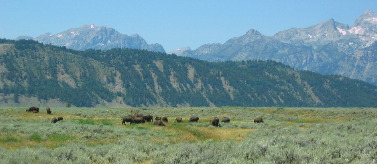

That
is a huge pile of morrain behind those grazing buffalo in the picture to the left.
Buffalo regularly traverse this pile of morrain along the Gros Ventre Road.
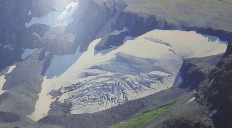
The
large glaciers that once dominated this region have retreated to their last vestiges
in the shadows of the high peaks. Although tiny compared to their ancestors, about
a dozen small glaciers provide excellent examples of how glaciers sculpt mountain
landscapes. All the parts of a glacier can be studied in compact Schoolroom Glacier
shown here.
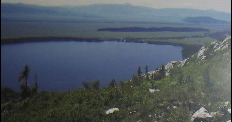
Jenny
Lake was created by a glacier several thousand feet thick. Signal Mountain is
the pile of morrain that glacier pushed in front of it before the earth started
warming and the glacier retreated.
Joyce had her dancing
shoes on while we were in Jackson and I can tell you, with certainty, that the
Million Dollar Cowboy Bar in Jackson will never be the same. VBG
Until next
time remember how good life is.
Mike & Joyce Hendrix